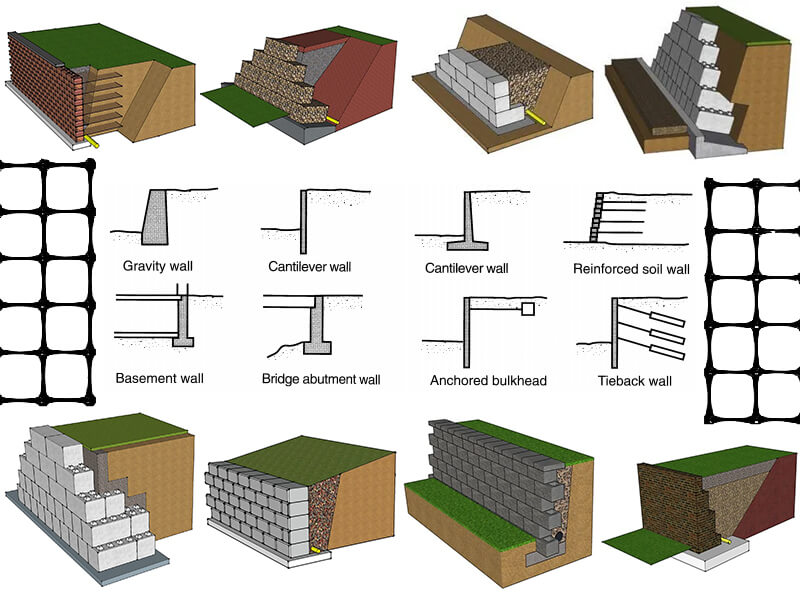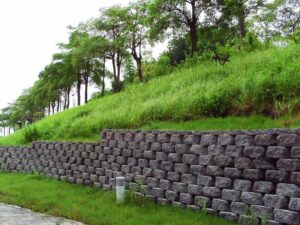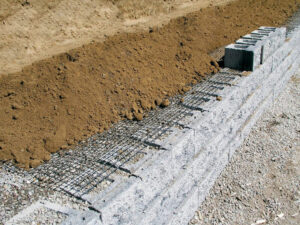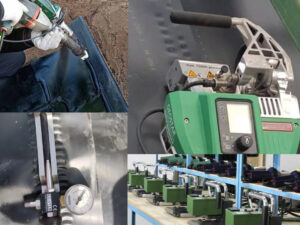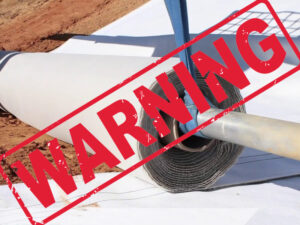Retaining walls can be divided into gravity, buttress and cantilever types, usually built with stone, brick, plain concrete, and reinforced concrete.
According to the function, structure, location, and wall material of the retaining wall, it can be further classified.
Now, let’s look at the specific types of retaining walls.
Introduction to the various components of retaining walls
- In the cross-section of a retaining wall, the part in direct contact with the supported soil is called the back of the wall.
- The part facing the air opposite the wall’s back is called the wall surface.
- The part in direct contact with the foundation is called the base.
- The top surface of the wall opposite the base is called the top of the wall.
- The front end of the base is called the toe of the wall.
- The rear end of the base is called the heel of the wall.
1. Wall structure
1) Wall back
The up-sloping wall back is suitable for the cutting wall and the shoulder wall or embankment wall with flat ground at the toe of the wall. The slope of the up-sloping wall back should not be slower than 1:0.3, usually 1:0.15~1:0.25.
The down-sloping wall back is suitable for embankment walls and shoulder walls, usually 1:0.15~1:0.25, and low walls not exceeding 4m can use vertical wall backs.
The convex broken line wall back is mostly used for cutting walls, and can also be used for shoulder walls. The wall height ratio of the upper and lower walls is generally 2:3.
The counterweight wall is suitable for shoulder walls and embankment walls in steep mountainous terrain, and can also be used for cutting walls. The slope of the up-sloping wall back of the upper wall is 1:0.25~1:0.45, and the up-sloping wall back of the lower wall is about 1:0.25. The wall height ratio of the upper and lower walls is generally 2:3.
2) Wall surface
The wall surface is generally flat, and the starting slope should be coordinated with the back slope of the wall.
The wall surface slope directly affects the height of the retaining wall. Therefore, when the horizontal slope of the ground is steep, the wall surface slope is generally 1:0.05~1:0.20, and the low wall can use a steep wall surface; when the ground is relatively flat, it is generally more economical to use 1:0.20~1:0.35.
3) Wall top
The width of the wall top is the smallest, not less than 50cm for mortar-laid retaining walls and not less than 60cm for dry-laid retaining walls.
The top of the mortar-laid shoulder wall should generally be made of coarse stone or concrete with a thickness of 40cm.
If no top cap is made, the top of the shoulder wall and the cutting wall should be built with large stones and grouting with mortar, or the top surface should be smoothed with No. 5 mortar, with a mortar thickness of 2cm.
The top of the dry-laid retaining wall should be within 50cm in height, and No. 25 mortar should be used to increase the stability of the wall. The height of the dry-laid retaining wall should generally not be greater than 6m.
4) Guardrails
Guardrails should be installed on the top of the shoulder wall in rugged areas or too high and too long to ensure traffic safety.
To maintain the minimum width of the earth’s shoulder, the distance between the inner edge of the guardrail and the edge of the road surface should not be less than 0.75m for second and third-grade roads and not less than 0.5m for fourth-grade roads.
Guardrails are divided into wall type and column type. The materials, guardrail height and width are determined according to actual needs.
2. Foundation structure
1) Foundation type
Most retaining walls are built directly on natural foundations.
When the bearing capacity of the foundation is insufficient and the terrain at the toe of the wall is relatively flat, and the wall body exceeds a certain height, to reduce the base compressive stress and increase the anti-overturning stability, the foundation is often expanded.
When the foundation compressive stress exceeds the foundation bearing capacity too much, a larger widening value is required. To avoid the steps of the widened part being too high, a reinforced concrete base plate can be used.
2) Foundation burial depth for soil foundation.
The foundation burial depth shall meet the following requirements:
① When there is no scouring, it shall be at least 1m below the natural ground.
② When there is scouring, it shall be at least 1m below the scouring line.
③ When affected by frost heave, it shall be at least 0.25m below the freezing line. When the freezing depth exceeds 1m, 1.25m shall be used, but the foundation shall be filled with a certain thickness of sand or gravel cushion layer, and the bottom surface of the cushion layer shall also be at least 0.25m below the freezing line.
3. Drainage facilities
The drainage measures of retaining walls usually consist of ground drainage and wall drainage.
1) Ground drainage
It is mainly to prevent surface water from seeping into the soil or foundation behind the wall. There are several methods:
① Set up ground drainage ditches to intercept surface water.
② Compact the top surface of backfill soil and loose soil on the surface to prevent rainwater and groundwater from seeping in. If necessary, a paving layer can be set.
③ The side ditch in front of the toe of the road-cutting retaining wall should be paved and reinforced to prevent the side ditch water from seeping into the foundation.
2) Wall drainage
A drainage pipe should be installed above the ground in front of the wall for the mortar block (sheet) stone wall.
When the wall is high, a drainage hole can be added to the upper part of the wall. The size of the drainage hole can be 5cm×10cm, 10cm×10cm, 15cm×20cm square holes, or 5~10cm round holes in diameter, depending on the amount of water discharged.
The hole spacing is generally 2~3m.
For the water-soaked retaining wall, the hole spacing is generally 1.0~1.5m, which can be appropriately increased in arid areas. The holes are staggered up and down, and the outlet of the lower drainage hole should be 0.3m higher than the ground in front of the wall or the water level in front of the wall.
To prevent water from seeping into the foundation, a 30cm thick clay waterproof layer should be laid at the bottom of the lower drainage hole, and a coarse aggregate filter layer should be set at the water inlet of the drainage hole to prevent the hole from being blocked.
When the backfill of the wall has poor permeability or frost heave may occur, sand and gravel with a thickness of not less than 0.3m should be laid in the range from the lowest drainage hole to 0.5m below the top of the wall.
4. Settlement joints and expansion joints
Smooth stones should be used on both sides of the dry-laid retaining wall joints to form vertical joints.
Classification of retaining walls
1. Classification by function:
Shoulder wall: shoulder protection and embankment wall for improving comprehensive slope.
Shrink the slope foot to prevent the slope or base (for steep slope embankment) from sliding, and the embankment along the river can prevent water flow erosion, etc.
Cut wall: reduce excavation and reduce the height of the slope.
Support the covering layer on the slope, which can also serve as a rock-blocking tunnel and open-hole retaining wall. Shorten the length of the tunnel or open the hole retaining wall at both ends of the bridge. Guard platform and connecting embankment, as wing wall or bridge abutment.
2. Classification by structure
(1) Gravity retaining wall
Gravity retaining wall balances the soil by its gravity. It is generally simple in type, easy to construct, requires a large amount of masonry work, and has high requirements for foundation.
According to the different wall back types, there are ordinary gravity retaining walls, folding wall back gravity retaining walls without counterweight platforms, and counterweight retaining walls.
A counterweight retaining wall is a gravity retaining wall.
Filling on the counterweight platform moves the center of gravity of the wall backward, increasing the stability of the wall. The wall chest is very steep, and the lower wall back is tilted upward, which can reduce the height of the wall and the earth excavation. However, the base area is small, and the foundation requirements are high.
(2) Anchored retaining wall
An anchored retaining wall is a light retaining wall, usually including anchor type and anchor plate type.
Anchored retaining wall is mainly composed of prefabricated reinforced concrete columns and retaining plates to form the wall surface, and is combined with horizontal or inclined steel anchor rods to support the soil. It mainly relies on the tensile force of the anchor rods buried in the rock and soil to pull the columns to ensure the stability of the soil.
Anchor plate type replaces the anchor rods with tie rods, and connects the anchor plate to the end in the soil. It is not suitable for road cuttings, but it is easy to implement embankment construction.
Anchored retaining wall: It is composed of prefabricated reinforced concrete columns and retaining plates to form the wall surface, and is combined with horizontal or inclined steel anchor rods.
One end of the anchor rod is connected to the column, and the other end is anchored in a stable rock or soil layer deep in the hillside.
Fixed plate retaining wall: It is a combined retaining structure composed of a reinforced concrete wall surface, steel tie rods, anchor plates and fill-in between.
Reinforced earth retaining wall: adding reinforcing materials into the soil, using the friction between the reinforcing materials and the soil to improve the deformation conditions of the soil and enhance the engineering properties of the soil, thereby achieving the purpose of stabilizing the soil.
(3) Thin-walled retaining wall
The thin-walled retaining wall is a reinforced concrete structure, including two main types: cantilever and buttress.
The cantilever retaining wall consists of a vertical wall and a bottom plate, with three cantilevers, namely the vertical wall, toe plate, and heel plate.
When the wall is high, rib plates (i.e. buttresses) can be erected along the length of the wall for a certain distance to connect the vertical wall plate and the heel plate, thus forming a buttress retaining wall.
When reinforcing old roads, considering that buttresses are difficult to build on the heel plate side, they can also be built on the toe plate side, which can also play a role, but design calculations must be carried out to determine.
Cantilever retaining wall: It consists of a vertical plate (wall panel) and a bottom plate (wall toe plate and wall heel plate).
Buttress retaining wall: When the height of the retaining wall h>10m, to increase the bending stiffness of the cantilever, a buttress is set every 0.8~1.0m along the longitudinal length of the wall.
(4) Reinforced earth retaining wall
The reinforced earth retaining wall is composed of three parts: fill, reinforcing material strips in the fill, and wall panels. It reduces the lateral pressure of the soil into the soil through the friction between the fill and the reinforcement to stabilize the soil.
Reinforced earth retaining wall is a flexible structure with great adaptability to foundation deformation and high building height, which is suitable for filling roadbeds.
However, the seepage stability of the fill behind the retaining board and the influence of foundation deformation on it must be considered, and selection needs to be made through calculation and analysis.
Geogrid Reinforced Soil Retaining Wall: Definition, Composition, Construction, Cost
(5) Other retaining walls
Pillar-slab retaining wall: commonly used in riverside embankments and foundation pit excavation
Pile-slab retaining wall: used in foundation pit excavation and flood control
Pile retaining wall: also known as frame retaining wall
3. Classification by the location of retaining walls
Road-cutting retaining wall: set at the bottom of the road-cutting slope, mainly used to support the hillside that cannot stabilize itself after excavation, and at the same time reduce the amount of excavation and reduce the height of the excavation slope.
Shoulder retaining wall: set at the shoulder, the top of the wall is a component of the shoulder, and its purpose is the same as that of the embankment wall. It can also protect important existing buildings on the adjacent route.
Embankment retaining wall: set below the high fill embankment or steep slope embankment, which can prevent the embankment slope or embankment from sliding along the base, and at the same time shrink the embankment foot, reduce the amount of fill, and reduce demolition and land occupation.
Hillside retaining wall: set above the road cutting or embankment, used to support the overburden, broken rock layer, or landslide on the hillside that may collapse.
Submerged retaining wall: along the river embankment, a retaining wall is set on the side of the water to prevent the water flow from scouring and eroding the roadbed, and it is also an effective measure to reduce the compression of the riverbed.
4. Classification by wall material
1) Stone retaining wall
2) Concrete retaining wall
3) Reinforced concrete retaining wall
4) Steel plate retaining wall
Summary
The above is the main structure and common classification of retaining walls. Of course, there are many more detailed classifications of retaining walls that are not listed here. If you are interested in this, please leave a comment.
QIVOC is a professional geosynthetics manufacturer. The main geogrid it produces is specially used to build reinforced soil retaining walls. If you need this material, please feel free to contact us.
Retaining Wall-Related Project Case
Kenya Nairobi West Ring Road Reinforced Earth Retaining Wall Project
Case Study of Reinforced Earth Retaining Wall Project of Center for Disease Control and Prevention
Reinforced Earth Retaining Wall Engineering for Hazardous Waste and Medical Waste Disposal Sites
Geogrids Used for Retaining Wall Construction in Highway Construction in Sichuan, China
Reinforced Retaining Wall Nairobi to Thika Expressway, Kenya
Reinforced Earth Retaining Wall: Mombasa-Mariakani Expressway Project, Kenya

